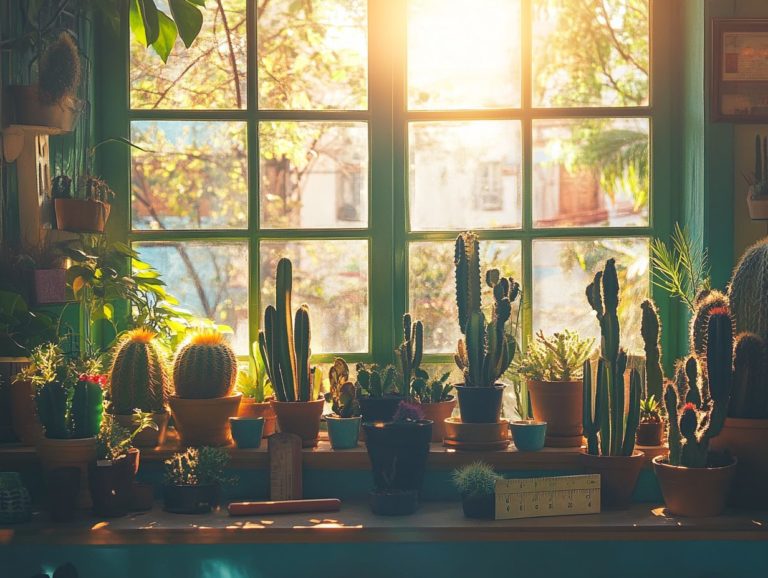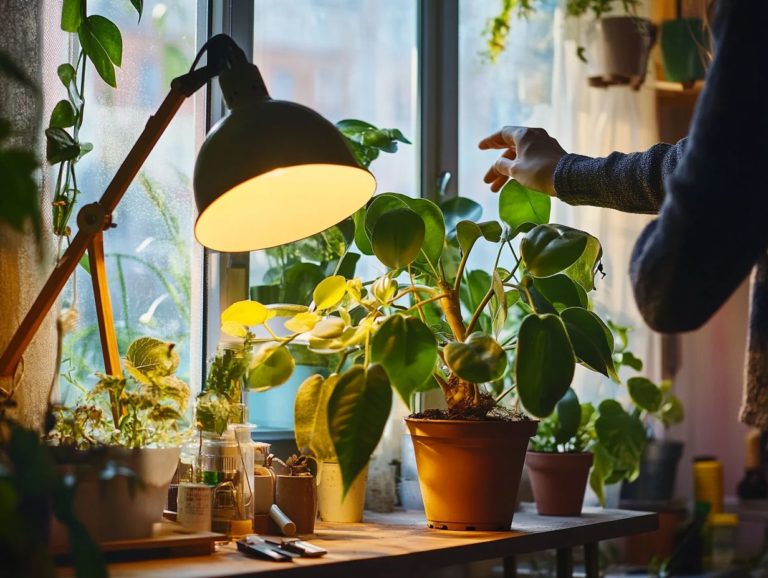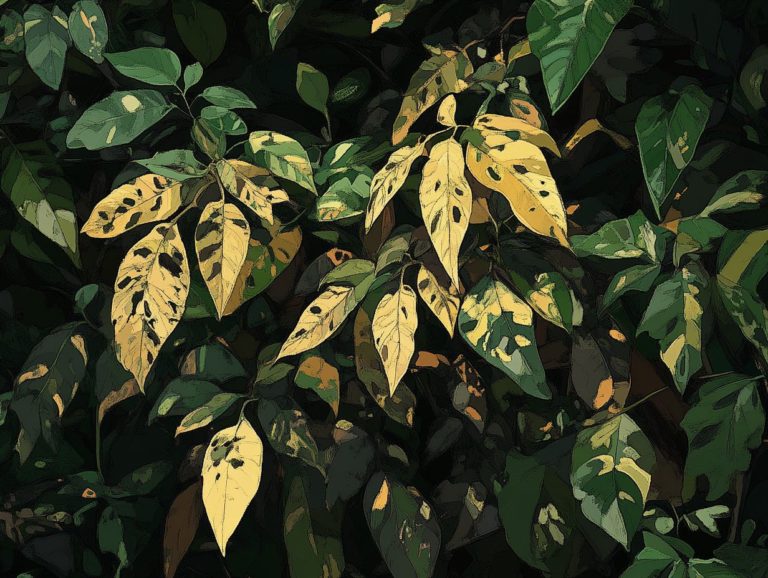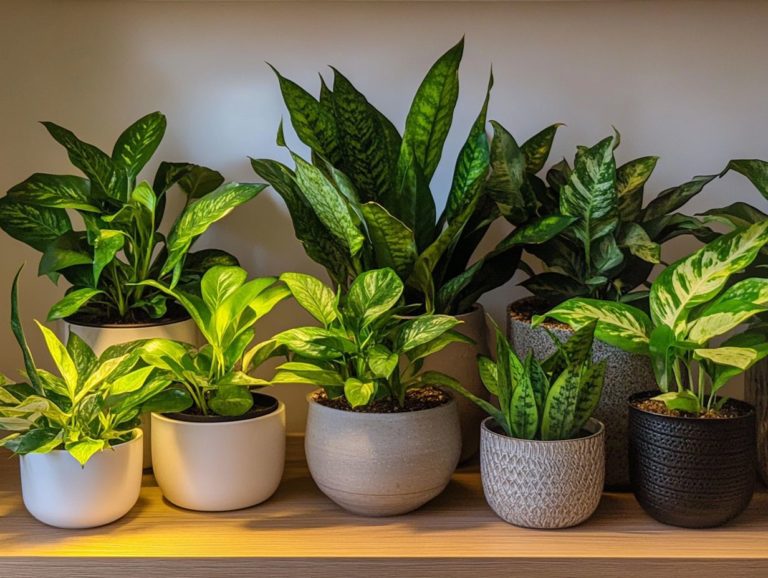Understanding Shade-Loving Plants
Shade-loving plants present an exquisite opportunity to transform the dimly lit corners of your garden into lush, vibrant retreats. Whether your goal is to elevate your landscape or enhance indoor air quality, these plants provide an array of benefits that shouldn’t be overlooked. From breathtaking flowering varieties to resilient ground covers, you’ll discover options that cater to every aesthetic taste.
Get ready to explore the amazing variety of shade-loving plants, learn how to select the perfect ones for your space, and uncover essential care tips while steering clear of common pitfalls. Prepare to infuse life into those shadowy areas!
Contents
Key Takeaways:
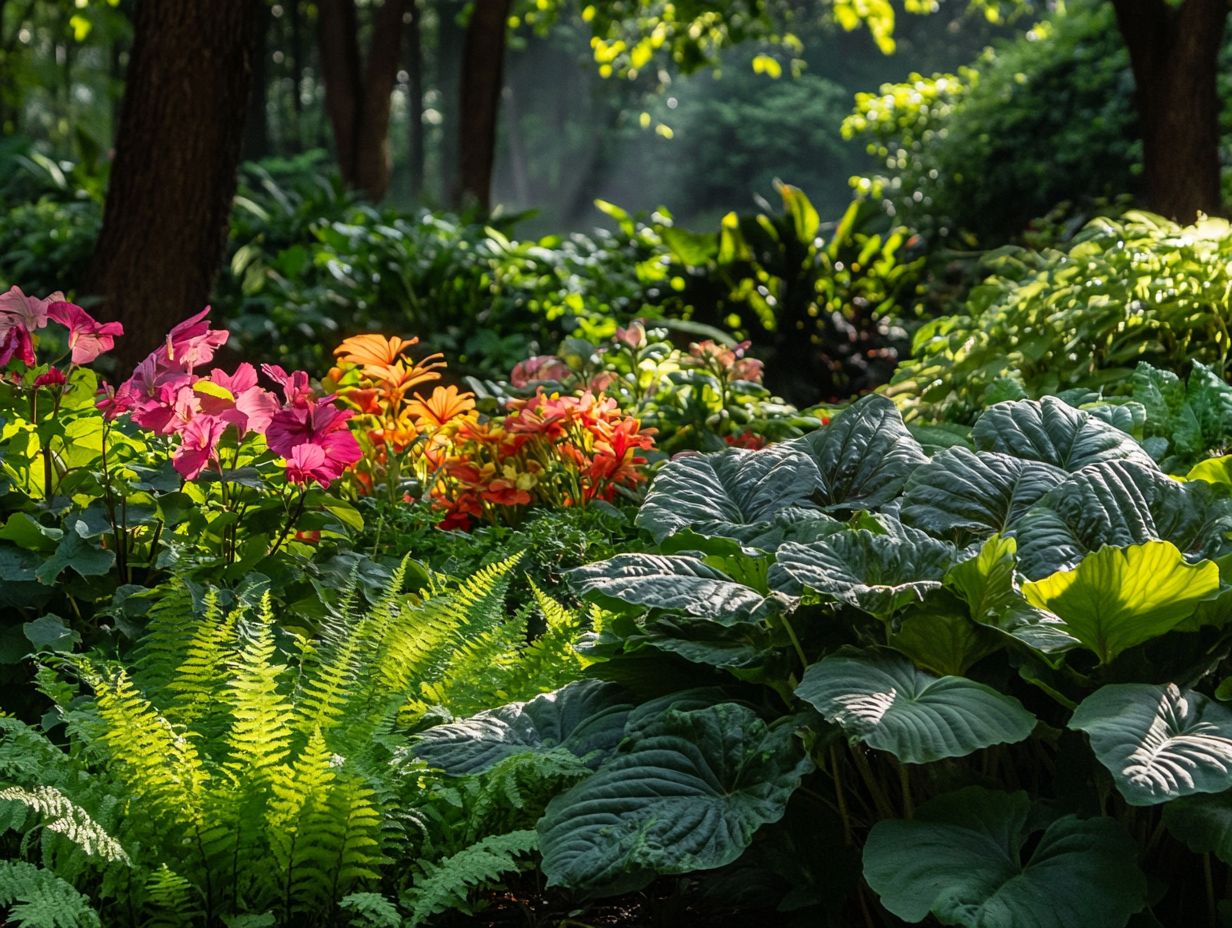
- Shade-loving plants offer environmental and health benefits, making them a great addition to any garden.
- There are various types of shade-loving plants, including flowering, foliage, and ground cover plants, to choose from.
- When choosing shade-loving plants, consider factors such as sunlight exposure, soil quality, shade requirements, and plant maintenance needs.
What are Shade-Loving Plants?
Shade-loving plants are your go-to allies for transforming those low-light corners of your garden into vibrant oases. They thrive in various conditions whether it s full shade, light shade, or dappled shade ensuring that even the trickiest gardening scenarios can be beautifully enhanced.
Understanding the specific shade needs of these plants is vital for successful shade gardening. Their growth responses can vary based on light exposure and moisture levels.
Many shade-tolerant vegetables, like leafy greens and certain herbs, adapt effortlessly to limited sunlight and a range of soil types and moisture conditions, making them incredibly versatile for any garden scenario. While some might thrive in rich, well-drained soils, others can flourish in more compacted or slightly wet ground.
By recognizing the different shade categories from partial to deep shade you can select the best varieties for your space. This knowledge enhances your gardening potential and fosters a thriving ecosystem where shade-loving plants contribute color and texture, enriching your entire landscape.
Benefits of Shade-Loving Plants
Shade-loving plants provide a wealth of benefits, elevating both the visual allure and the health of the garden. Thriving in low-light conditions, these plants not only flourish but also bolster the health of surrounding flora by enriching soil fertility and enhancing moisture retention.
This nurturing quality helps establish microclimates within shaded areas, creating a harmonious environment. By incorporating a diverse selection of shade plants, you contribute to a more sustainable garden that effectively manages sunlight and improves overall environmental conditions.
Environmental and Health Benefits
The environmental and health benefits of shade-loving plants are truly remarkable, especially in urban areas where green spaces are often scarce. These plants create essential microclimates, regulate soil moisture, and enhance soil fertility, nurturing healthy plants and supporting local ecosystems.
By choosing the right shade plants for your garden, you can boost biodiversity, improve air quality, and contribute to a more sustainable environment. Cultivating these species allows you to appreciate their aesthetic charm while recognizing their vital role in counteracting the heat effects prevalent in concrete-dominated settings.
This translates to cooler temperatures and lower energy costs for your cooling systems. Shade-loving plants improve the health of the surrounding soil with their deep-root systems, which combat erosion and enhance nutrient cycling.
The diversity of plant species also attracts beneficial insects and pollinators, fostering a vibrant ecosystem that promotes overall wellness for both you and the environment. Start transforming your garden today with these incredible plants!
Types of Shade-Loving Plants
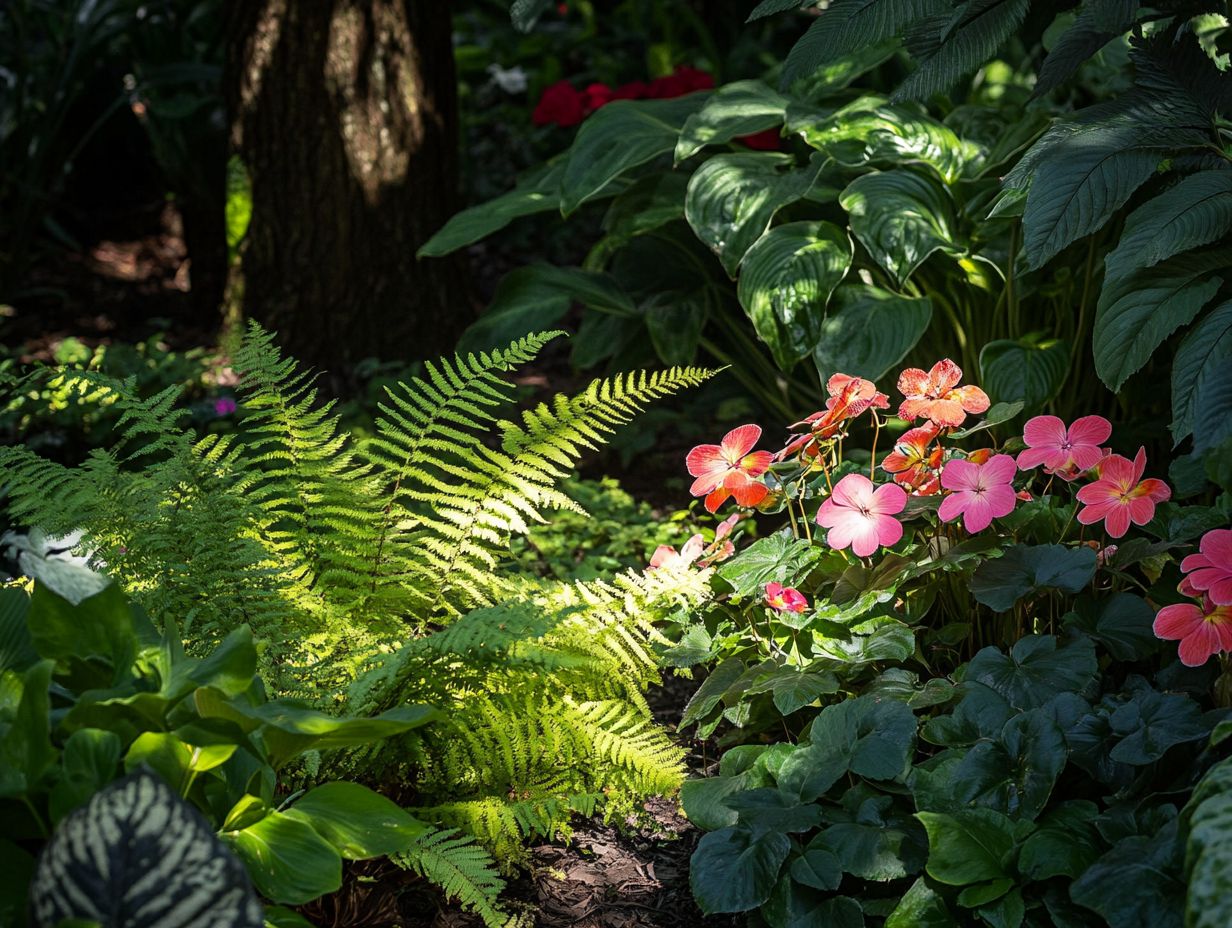
You ll find a rich array of shade-loving plants, each one tailored to meet various gardening needs and conditions, including shade avoiders and shade-tolerant varieties (plants that can thrive with limited sunlight). You can easily classify these plants into several categories, including flowering plants, foliage plants, and ground cover options.
Don t overlook shade-tolerant vegetables like rhubarb and redcurrants. Understanding the details of these different plant types and their specific shade requirements is crucial for mastering effective garden planning and achieving success in shaded areas.
Flowering, Foliage, and Ground Cover Plants
Flowering, foliage, and ground cover plants each play vital roles in crafting vibrant and diverse shade gardens, enhancing the aesthetic appeal of your landscape. Consider flowering plants like hydrangeas and begonias, which deliver delightful bursts of color in those shadowy spots.
Foliage plants, such as Zantedeschia and wild ginger, introduce texture and depth, enriching the garden’s overall appeal. Ground cover plants are not just pretty faces; they help manage soil moisture and elevate aesthetics, making them critical in any successful shade gardening strategy.
By thoughtfully selecting your varieties, you can strike a harmonious balance among these three categories, allowing for better management of growing conditions in shaded areas. Picture this: the ethereal blooms of astilbes harmonizing with the lush, broad leaves of hostas, creating a stunning visual spectacle.
Incorporating shade-loving ground covers like creeping thyme or ivy does more than beautify; it fills in those empty gaps and keeps weeds at bay, merging practicality with elegance. By understanding the unique traits of each plant type, you can arrange them thoughtfully, transforming dimly lit areas into flourishing retreats that showcase the rich palette of possibilities in your shade garden.
Choosing the Right Shade-Loving Plants
Selecting the appropriate shade-loving plants is essential for cultivating a flourishing garden in shaded areas. It s important to understand the specific shade requirements, moisture levels, and soil conditions of the plants you re considering.
Considering factors like plant hardiness and growth responses can significantly boost your success, resulting in vibrant, healthy plants that thrive in both light and deep shade environments.
Factors to Consider
When you re choosing shade-loving plants, there are several critical factors to keep in mind. Consider the shade requirements, which can range from light shade to full shade, alongside soil quality and moisture levels specific to those shaded areas. Understanding how different plants respond to light helps you choose the right ones.
Start by evaluating the lighting conditions in various parts of your garden throughout the day. Take note of how much light filters through the canopy or surrounding structures; this will guide your selection of plants that flourish in those specific environments.
Soil quality is just as crucial. A simple soil test can uncover pH levels and organic matter content, ensuring that the shade-loving species you choose will truly thrive.
Don t overlook moisture levels either some plants prefer consistently damp soil, while others are more tolerant of drier conditions. By paying close attention to these elements, you can create a lush landscape that flourishes in shade.
Caring for Shade-Loving Plants
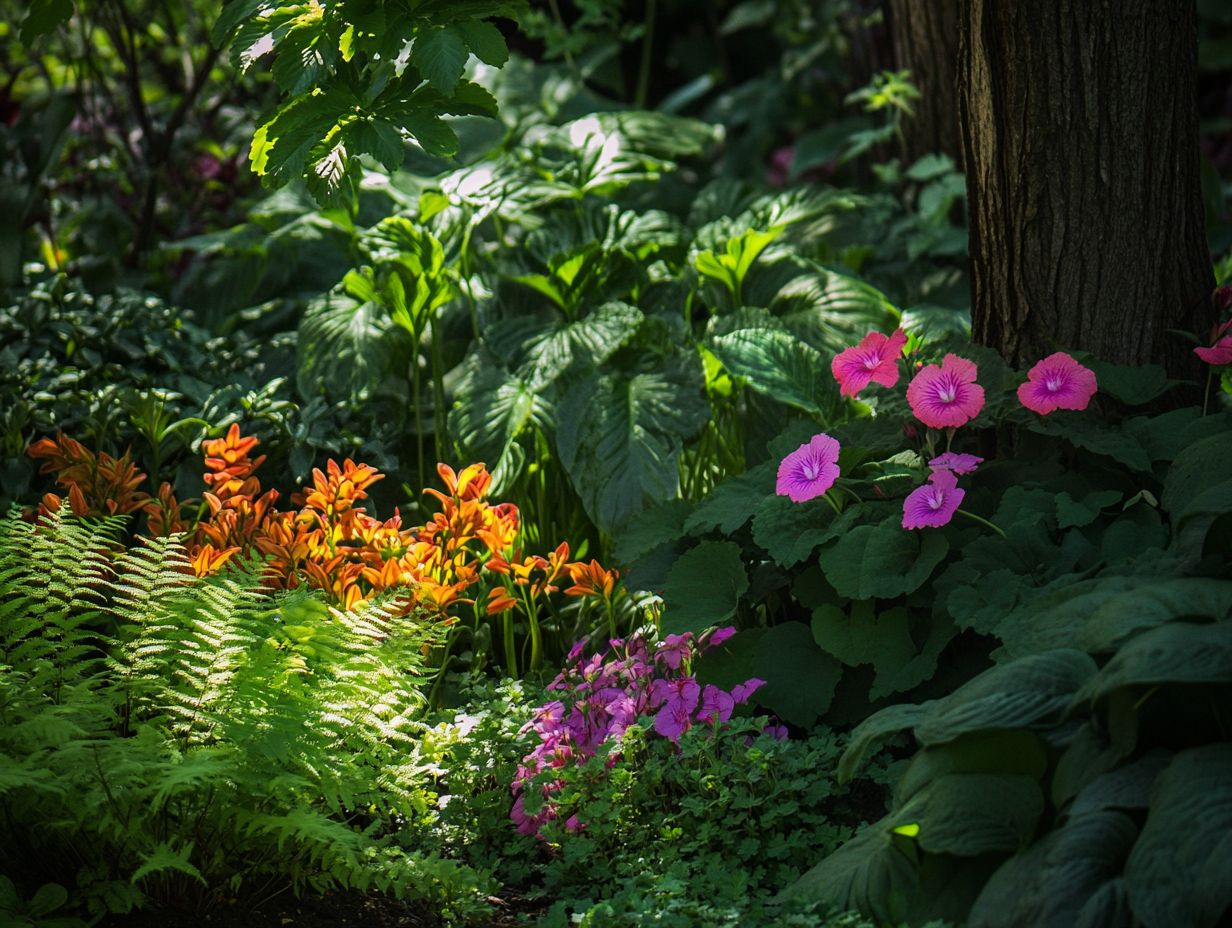
Caring for shade-loving plants demands your attention to their distinct needs, which can differ considerably from those of sun-loving varieties. Key elements of their care include mastering proper watering techniques to ensure the right soil moisture levels, timing your fertilization strategically to boost growth.
Also, practice occasional pruning to encourage vibrant foliage and shape. By grasping the specific requirements of shade plants, you can cultivate optimal growing conditions that nurture your plants in those shaded corners of your garden.
Watering, Fertilizing, and Pruning Tips
Effective watering, fertilizing, and pruning are essential for maintaining the vitality of your shade-loving plants. To help these plants thrive, customize your watering habits based on the specific needs of each variety you care for.
Regularly check the soil moisture particularly in the top inch to determine the optimal watering schedule. Aiming for a deep watering once a week is ideal, especially during drier months.
For fertilizing, choose a balanced organic mix during the growing season to enhance growth without the risk of chemical burn, which can harm plants. Pruning should be approached thoughtfully. Remove dead or overcrowded stems to improve air circulation and bolster the overall health of your plants, allowing them to flourish in their lush environments.
Common Mistakes to Avoid
Gardening in shade can be a rewarding endeavor. Discovering common mistakes can save your garden!
One critical aspect is accurately assessing the levels of shade; overlooking this can set you back. Neglecting soil conditions and underestimating the specific needs of different plant types may lead to challenges in nurturing healthy growth.
By understanding these pitfalls and applying thoughtful gardening strategies, you can sidestep issues and cultivate a thriving shade garden that flourishes beautifully.
Potential Pitfalls and How to Avoid Them
Identifying potential pitfalls in shade gardening enables you to take proactive steps toward success. Common missteps include selecting the wrong plants for specific shade conditions, overwatering due to misjudged soil moisture levels, or neglecting to provide enough light exposure for shade-tolerant plants.
Recognizing that not all shade is created equal is essential. Some areas may offer spotted sunlight, while others provide deep, dense cover. This distinction is crucial; choosing plants that thrive in the wrong conditions can lead to disappointing outcomes. For example, planting sun-loving varieties in a consistently dark corner can be a recipe for disaster. It’s also vital to keep an eye on drainage; soggy soil can stunt growth and encourage disease. Additionally, consider using light shades for indoor plants to optimize their exposure.
By considering these factors and curating a diverse selection of well-suited plants, you can create lush, thriving spaces that flourish even in the shadows.
Frequently Asked Questions

What are shade-loving plants?
Shade-loving plants thrive in low light environments and do not require direct sunlight to grow and flourish.
What types of plants are considered shade-loving?
Shade-loving plants can vary from ferns to hostas to certain types of flowers and vegetables. Some plants, like impatiens, tolerate partial shade but prefer full shade environments.
Do shade-loving plants still need some sunlight?
Yes, all plants need some form of sunlight to survive, even shade-loving plants. While they thrive in low light conditions, it’s important for them to receive some natural light for photosynthesis.
How do I know if a plant is suitable for a shaded setting?
Research the specific plant’s light requirements or ask a local garden center for recommendations. Typically, plants with darker or more textured leaves tend to do well in shade.
Can I grow shade-loving plants indoors?
Yes, many shade-loving plants can be grown indoors as long as they still receive some natural light. Choose a plant suitable for indoor conditions and provide proper care, such as watering and fertilizing.
What are the benefits of having shade-loving plants in my garden?
Shade-loving plants add texture and depth to your garden, providing a lush and vibrant look to shady areas. They also require less maintenance compared to plants that need full sun, making them ideal for busy gardeners.
If you have more questions or want to share your gardening experiences, feel free to reach out!

